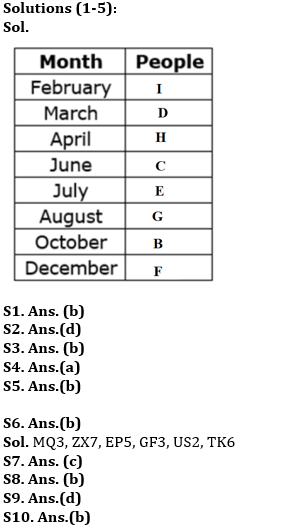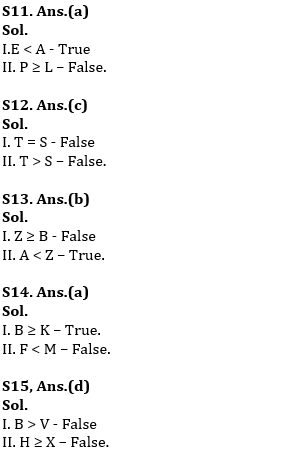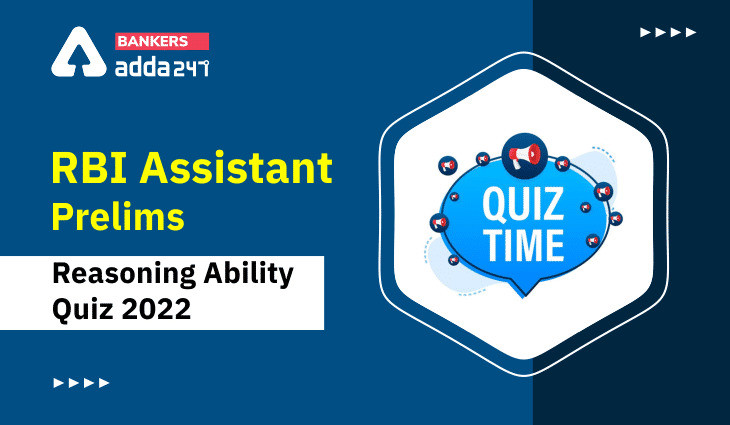Directions (1-5): Study the following information carefully and answer the following question.
Eight people i.e., B, C, D, E, F, G, H and I going to an amusement park on eight different months i.e., February, March, April, June, July, August, October and December. All the information is not necessarily in the same order. H goes in the month having 30 days. Three people go between H and B. I goes in the month having less than 31 days. Two people go between I and C. D goes before C in the month having 31 days but not in July. No one goes between E and G. One person goes between G and F.
Q1. How many people go after E?
(a) One
(b) Three
(c) None
(d) Four
(e) None of these
Q2. How many people go between H and C?
(a) Two
(b) Three
(c) One
(d) None
(e) Four
Q3. Who goes on August?
(a) F
(b) G
(c) E
(d) B
(e) None of these
Q4. Find the odd one.
(a) I
(b) G
(c) E
(d) D
(e) F
Q5. Who goes between I and H?
(a) C
(b) D
(c) E
(d) G
(e) None of these
Directions (6-10): Study the digit-letter sequence carefully and answer the questions given below:
N 1 M Q 3 W 4 A 8 Z X 7 R E P 5 L O 9 G F 3 U S 2 T K 6 B C
Q6. How many consonants are there which are immediately followed by a number and immediately preceded by a letter?
(a) Four
(b) Six
(c) Five
(d) Seven
(e) None of these
Q7. If all the vowels are removed from the given series, then which amongst the following element is twelfth from the left end?
(a) 7
(b) X
(c) R
(d) P
(e) None of these
Q8. Which amongst the following element is ninth to the left of the seventeenth element from the left end?
(a) Q
(b) A
(c) W
(d) 4
(e) None of these
Q9. How many numbers are there which are immediately followed by a vowel?
(a) Three
(b) None
(c) One
(d) Two
(e) None of these
Q10. Which amongst the following element is seventh to the right of the eighth element from the left end?
(a) E
(b) P
(c) 5
(d) L
(e) None of the above
Directions (11-15): In the following questions, a statement or statements are given followed by some conclusions. Study the following data carefully and answer the questions accordingly.
Q11. Statements: P > D ≥ E = T ≤ S < L ≤ A, B ≥ C > Z = H
Conclusions:
I.E < A
II.P ≥ L
(a) If only conclusion I follows
(b) If only conclusion II follows
(c) If either conclusion I or II follows
(d) If neither conclusion I nor II follows
(e) If both conclusions I and II follow
Q12. Statements: E = P > C ≥ D = S ≤ R < L ≤ A, T ≥ C > Z = N
Conclusions:
I. T = S
II. T > S
(a) If only conclusion I follows
(b) If only conclusion II follows
(c) If either conclusion I or II follows
(d) If neither conclusion I nor II follows
(e) If both conclusions I and II follow
Q13. Statements: B = M < Q ≤ Z ≥ S = T, Q = I > A
Conclusions:
I. Z ≥ B
II. A < Z
(a) If only conclusion I follows
(b) If only conclusion II follows
(c) If either conclusion I or II follows
(d) If neither conclusion I nor II follows
(e) If both conclusions I and II follow
Q14. Statements: Z > T ≥ F, B ≥ I ≥ J = K > Z > M > N
Conclusions:
I. B ≥ K
II. F < M
(a) If only conclusion I follows
(b) If only conclusion II follows
(c) If either conclusion I or II follows
(d) If neither conclusion I nor II follows
(e) If both conclusions I and II follows
Q15. Statements: B = H ≥ V < W > X > Y > Z, W = O > A < M
Conclusions:
I. B > V
II. H ≥ X
(a) If only conclusion I follows
(b) If only conclusion II follows
(c) If either conclusion I or II follows
(d) If neither conclusion I nor II follows
(e) If both conclusions I and II follows
Solutions










 GA Capsule for SBI Clerk Mains 2025, Dow...
GA Capsule for SBI Clerk Mains 2025, Dow...
 The Hindu Review October 2022: Download ...
The Hindu Review October 2022: Download ...
 RBI Grade B Syllabus 2025 and Exam Patte...
RBI Grade B Syllabus 2025 and Exam Patte...





